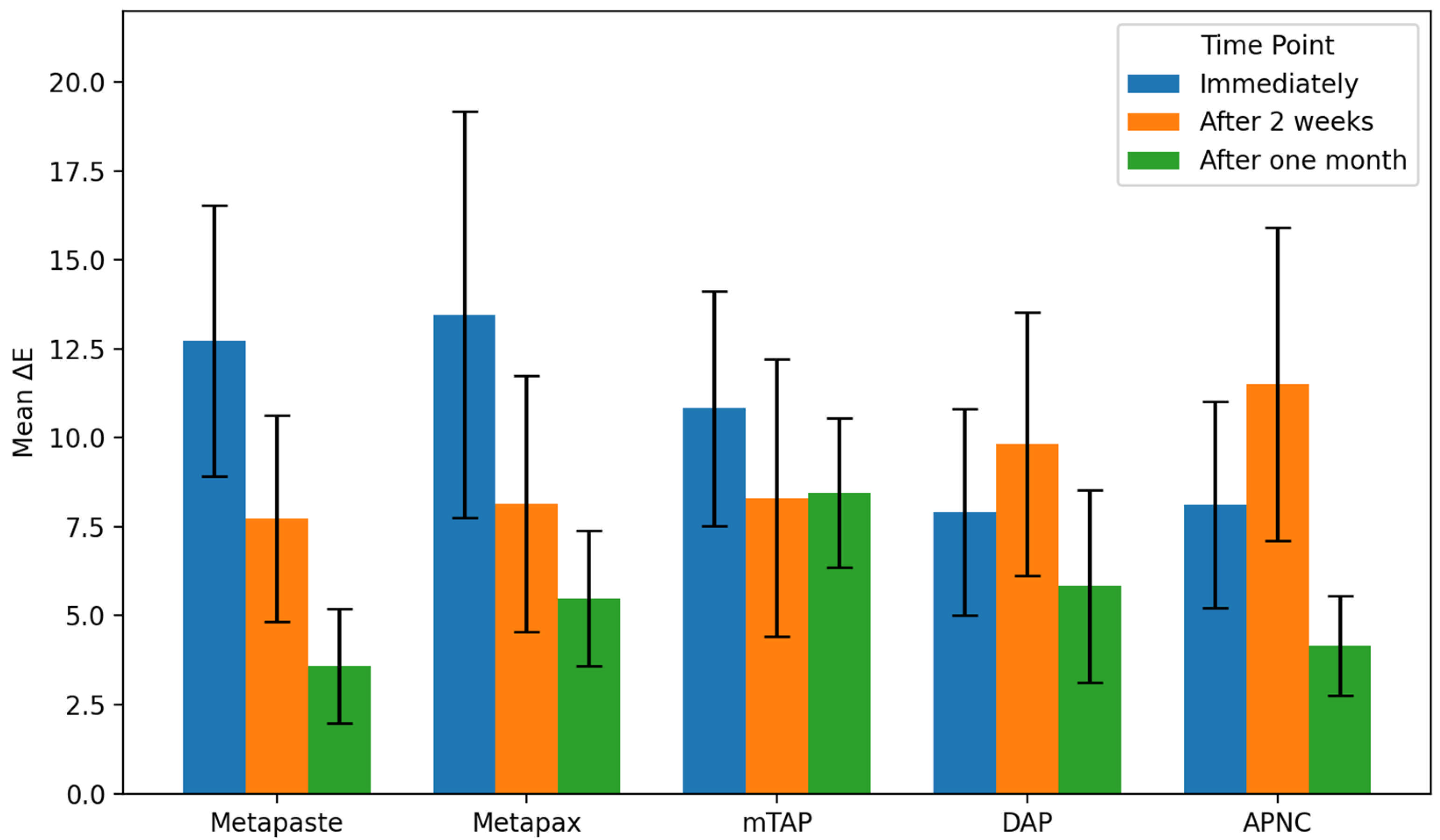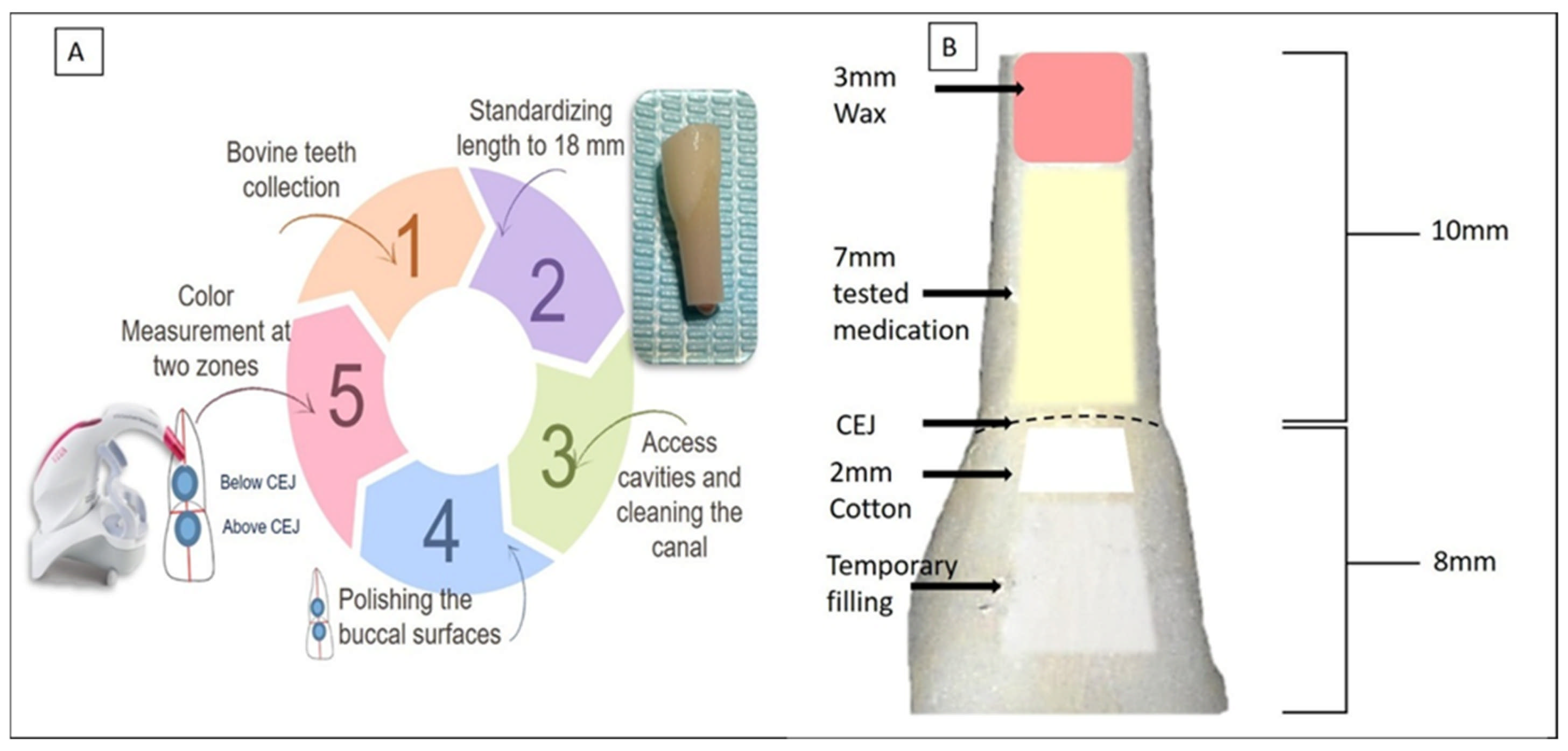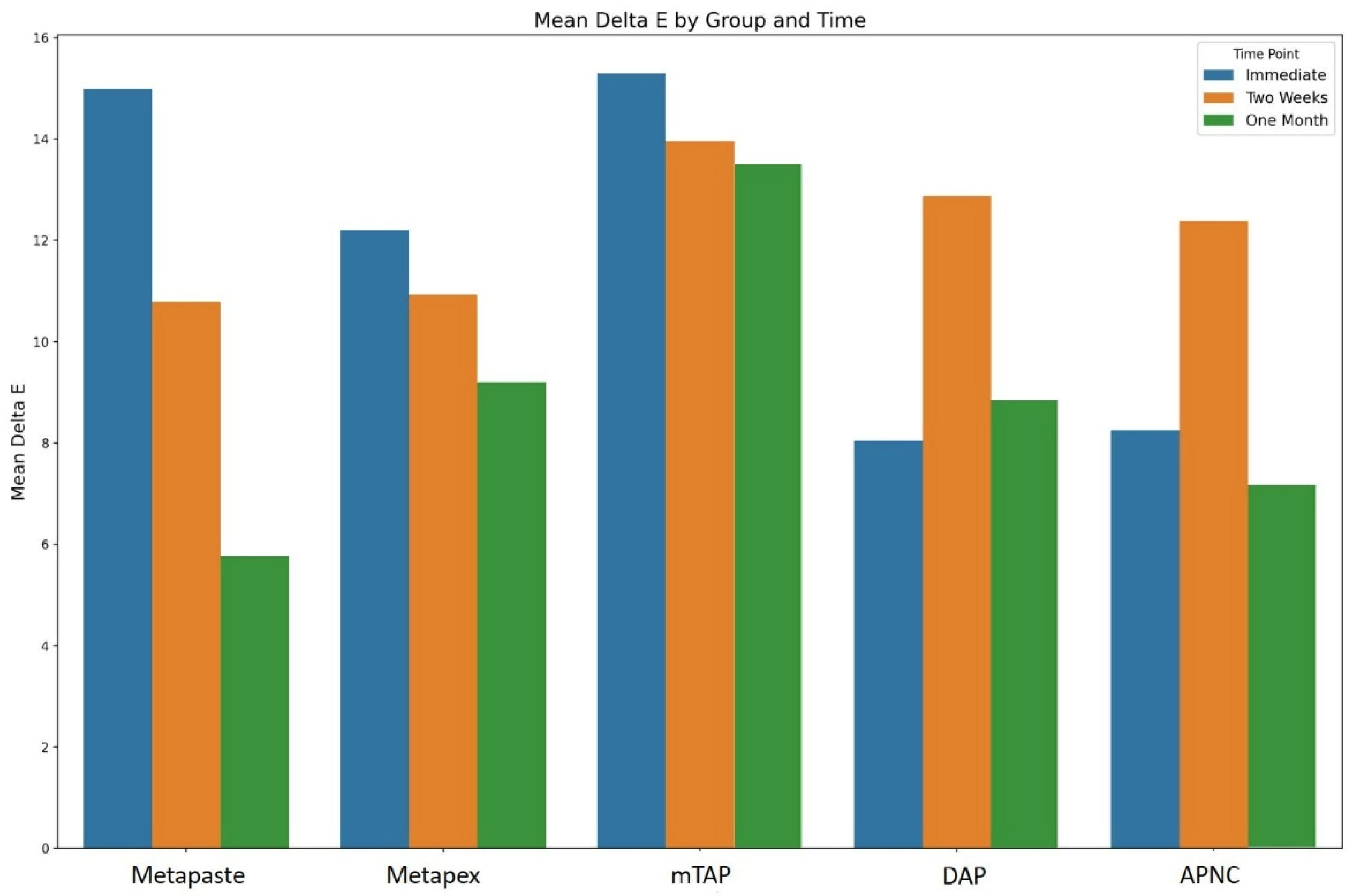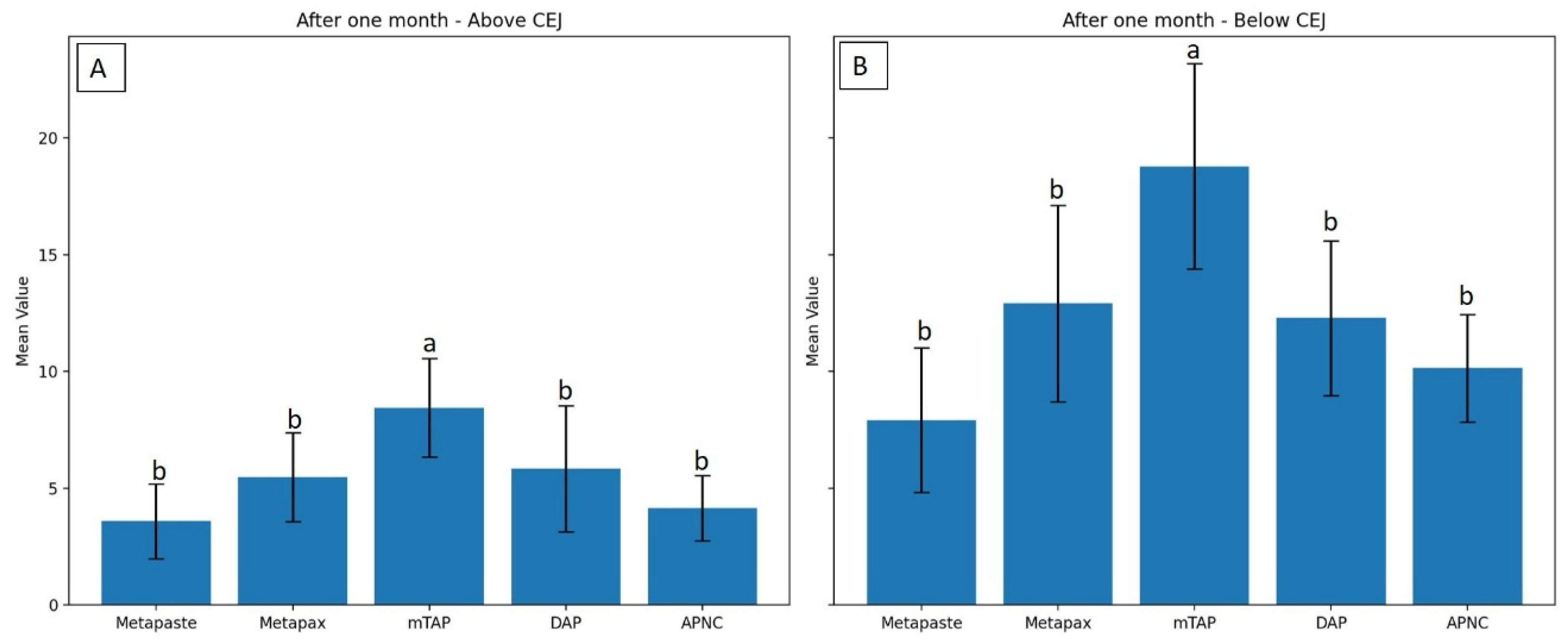Comparative Evaluation of Tooth Discoloration Induced by an Experimental Antibiotic Paste Modified with Nano Chitosan: An In Vitro Study
Abstract
1. Introduction
2. Materials and Methods
2.1. Sample Size Calculation and Selection
2.2. Sample Preparation
2.3. Baseline Color Measurements
2.4. Preparation of Tested Materials
2.5. Application of Tested Materials
Color Measurement over Observational Time Points
2.6. Statistical Analysis
3. Results
3.1. Discoloration Above CEJ (Figure 4)

3.2. Discoloration Below CEJ (Figure 5)

4. Discussion
5. Conclusions
Author Contributions
Funding
Institutional Review Board Statement
Data Availability Statement
Conflicts of Interest
Abbreviations
| CEJ | Cemento-enamel junction |
| mTAP | modified Triple Antibiotic Paste Directory |
| DAP | Double Antibiotic Paste |
| APNC | Antibiotic paste modified with Nano Chitosan |
References
- Murvindran, V.; Raj, J.D. Antibiotics as an intracanal medicament in endodontics. J. Pharm. Sci. Res. 2014, 6, 297–301. [Google Scholar]
- Shaik, J.; Garlapati, R.; Nagesh, B.; Sujana, V.; Jayaprakash, T.; Naidu, S. Comparative evaluation of antimicrobial efficacy of triple antibiotic paste and calcium hydroxide using chitosan as carrier against Candida albicans and Enterococcus faecalis: An in vitro study. J. Conserv. Dent. 2014, 17, 335. [Google Scholar] [CrossRef] [PubMed]
- Verma, P.; Ansari, A.; Tikku, A.P.; Chandra, A.; Yadav, R.K.; Bharti, R.; Bains, R. Effect of intracanal medicaments on radicular dentine: An attenuated total reflection-Fourier-transform infrared spectroscopy analysis. Asian J. Oral Health Allied Sci. 2020, 10, 12–18. [Google Scholar] [CrossRef]
- Sato, I.; Ando-Kurihara, N.; Kota, K.; Iwaku, M.; Hoshino, E. Sterilization of infected root-canal dentine by topical application of a mixture of ciprofloxacin, metronidazole and minocycline in situ. Int. Endod. J. 1996, 29, 118–124. [Google Scholar] [CrossRef]
- Windley, W., 3rd; Teixeira, F.; Levin, L.; Sigurdsson, A.; Trope, M. Disinfection of immature teeth with a triple antibiotic paste. J. Endod. 2005, 31, 439–443. [Google Scholar] [CrossRef]
- Hoshino, E.; Kurihara-Ando, N.; Sato, I.; Uematsu, H.; Sato, M.; Kota, K.; Iwaku, M. In-vitro antibacterial susceptibility of bacteria taken from infected root dentine to a mixture of ciprofloxacin, metronidazole and minocycline. Int. Endod. J. 1996, 29, 125–130. [Google Scholar] [CrossRef]
- Ruparel, N.B.; Teixeira, F.B.; Ferraz, C.C.; Diogenes, A. Direct effect of intracanal medicaments on survival of stem cells of the apical papilla. J. Endod. 2012, 38, 1372–1375. [Google Scholar] [CrossRef]
- Akcay, M.; Arslan, H.; Yasa, B.; Kavrık, F.; Yasa, E. Spectrophotometric analysis of crown discoloration induced by various antibiotic pastes used in revascularization. J. Endod. 2014, 40, 845–848. [Google Scholar] [CrossRef]
- Kahler, B.; Rossi-Fedele, G. A review of tooth discoloration after regenerative endodontic therapy. J. Endod. 2016, 42, 563–569. [Google Scholar] [CrossRef]
- Santos, L.; Chisini, L.A.; Springmann, C.G.; Souza, B.D.M.; Pappen, F.G.; Demarco, F.F.; Felippe, M.C.S.; Felippe, W.T. Alternative to Avoid Tooth Discoloration after Regenerative Endodontic Procedure: A Systematic Review. Braz. Dent. J. 2018, 29, 409–418. [Google Scholar] [CrossRef]
- Lenherr, P.; Allgayer, N.; Weiger, R.; Filippi, A.; Attin, T.; Krastl, G. Tooth discoloration induced by endodontic materials: A laboratory study. Int. Endod. J. 2012, 45, 942–949. [Google Scholar] [CrossRef] [PubMed]
- American Association of Endodontists. AAE Clinical Considerations for a Regenerative Procedure; American Association of Endodontists: Chicago, IL, USA, 2016. [Google Scholar]
- Elmallah, S.S.; Obeid, M.F.; Elsayed, M.A. Comparative evaluation of macro-form and nano-form of bioactive glass and triple antibiotic paste on fracture resistance of root dentin. Tanta Dent. J. 2020, 17, 114–118. [Google Scholar]
- Elsayed, M.A.; Elbanna, A.; Rahman, M.M.; Youssef, M. Comparative Evaluation of the Antibacterial Effect of Different Combinations of Etidronate, Nanochitosan and NaOCl on E. Faecalis Biofilm. J. Int. Dent. Medical Res. 2022, 15, 1429–1433. [Google Scholar]
- Sanap, P.; Hegde, V.; Ghunawat, D.; Patil, M.; Nagaonkar, N.; Jagtap, V. Current applications of chitosan nanoparticles in dentistry: A review. Int. J. Appl. Dent. Sci. 2020, 6, 81–84. [Google Scholar] [CrossRef]
- Husain, S.; Al-Samadani, K.H.; Najeeb, S.; Zafar, M.S.; Khurshid, Z.; Zohaib, S.; Qasim, S.B. Chitosan biomaterials for current and potential dental applications. Materials 2017, 10, 602. [Google Scholar] [CrossRef]
- Islam, M.S.; Padmanabhan, V.; Shanati, K.A.; Naser, A.M.; Hashim, N.T.; Aryal, A.C.S. Comparative Analysis of Whitening Outcomes of Over-the-Counter Toothpastes: An In Vitro Study. Dent. J. 2025, 13, 45. [Google Scholar] [CrossRef]
- Kim, S.G.; Malek, M.; Sigurdsson, A.; Lin, L.M.; Kahler, B. Regenerative endodontics: A comprehensive review. Int. Endod. J. 2018, 51, 1367–1388. [Google Scholar] [CrossRef]
- Segura-Egea, J.J.; Gould, K.; Şen, B.H.; Jonasson, P.; Cotti, E.; Mazzoni, A.; Sunay, H.; Tjäderhane, L.; Dummer, P.M.H. Antibiotics in Endodontics: A review. Int. Endod. J. 2017, 50, 1169–1184. [Google Scholar] [CrossRef]
- Gougousis, K.; Giannakoulas, D.G.; Taraslia, V.; Agrafioti, A.; Anastasiadou, E.; Kontakiotis, E.G. Number of Dental Stem Cells on Root Canal Dentin after Application of Triple Antibiotic Paste or Calcium Hydroxide: An In Vitro Study. Eur. J. Dent. 2019, 13, 161–165. [Google Scholar] [CrossRef]
- Montero-Miralles, P.; Martin-Gonzalez, J.; Alonso-Ezpeleta, O.; Jimenez-Sanchez, M.C.; Velasco-Ortega, E.; Segura-Egea, J.J. Effectiveness and clinical implications of the use of topical antibiotics in regenerative endodontic procedures: A review. Int. Endod. J. 2018, 51, 981–988. [Google Scholar] [CrossRef]
- Sánchez, A.R.; Rogers, R.S., III; Sheridan, P.J. Tetracycline and other tetracycline-derivative staining of the teeth and oral cavity. Int. J. Dermatol. 2004, 43, 709–715. [Google Scholar] [CrossRef] [PubMed]
- Kohli, M.R.; Yamaguchi, M.; Setzer, F.C.; Karabucak, B. Spectrophotometric analysis of coronal tooth discoloration induced by various bioceramic cements and other endodontic materials. J. Endod. 2015, 41, 1862–1866. [Google Scholar] [CrossRef] [PubMed]
- Cheek, C.C.; Heymann, H.O. Dental and oral discolorations associated with minocycline and other tetracycline analogs. J. Esthet. Dent. 1999, 11, 43–48. [Google Scholar] [CrossRef] [PubMed]
- Nagata, J.Y.; Gomes, B.P.; Rocha Lima, T.F.; Murakami, L.S.; de Faria, D.E.; Campos, G.R.; de Souza-Filho, F.J.; Soares Ade, J. Traumatized immature teeth treated with 2 protocols of pulp revascularization. J. Endod. 2014, 40, 606–612. [Google Scholar] [CrossRef]
- Swaroop, A.E.; Mathew, S.; Harshini, P.; Nagaraja, S. Local drug delivery for regeneration and disinfection in endodontics: A narrative review. J. Conserv. Dent. Endod. 2025, 28, 119–125. [Google Scholar] [CrossRef]
- Rahmati, A.; Seyedein, F.; Dianat, O.; Saedi, S.; Rostami, G.; Akbarzadeh Baghban, A.; Sabertahan, S.; Kazem, M. Effect of Calcium Hydroxide Versus Double Antibiotic Paste on Endodontic Treatment Outcomes in Teeth with Large Periapical Lesions: A Triple-Blind Randomized Clinical Trial. Int. J. Dent. 2024, 2024, 7071459. [Google Scholar] [CrossRef]
- Dettwiler, C.A.; Walter, M.; Zaugg, L.K.; Lenherr, P.; Weiger, R.; Krastl, G. In vitro assessment of the tooth staining potential of endodontic materials in a bovine tooth model. Dent. Traumatol. 2016, 32, 480–487. [Google Scholar] [CrossRef]
- Galler, K.; Krastl, G.; Simon, S.; Van Gorp, G.; Meschi, N.; Vahedi, B.; Lambrechts, P. European Society of Endodontology position statement: Revitalization procedures. Int. Endod. J. 2016, 49, 717–723. [Google Scholar] [CrossRef]
- Kim, D.; Kim, E. Antimicrobial effect of calcium hydroxide as an intracanal medicament in root canal treatment: A literature review—Part II. In vivo studies. Restor. Dent. Endod. 2015, 40, 97–103. [Google Scholar] [CrossRef]
- Yassen, G.H.; Chu, T.-M.G.; Eckert, G.; Platt, J.A. Effect of medicaments used in endodontic regeneration technique on the chemical structure of human immature radicular dentin: An in vitro study. J. Endod. 2013, 39, 269–273. [Google Scholar] [CrossRef]
- Barge, P.; Jadhav, R.J.; Shaikh, S.; Kadam, A.S.; Sidral, S.Y. Comparative Evaluation of Novel Intracanal Medicaments on the Sealing Integrity of the Root Canal System: An In Vitro Study. Cureus 2024, 16, e72424. [Google Scholar] [CrossRef] [PubMed]
- Kwon, W.; Kim, I.H.; Kang, C.M.; Kim, B.; Shin, Y.; Song, J.S. Comparative study of pulpal responses to ProRoot MTA, Vitapex, and Metapex in canine teeth. J. Dent. Sci. 2021, 16, 1274–1280. [Google Scholar] [CrossRef] [PubMed]
- Kassaee, M.; Hosseini, S.; Elahi, S.H.; Bolhari, B. A new nano-chitosan irrigant with superior smear layer removal and penetration. Nanochem. Res. 2016, 1, 150–156. [Google Scholar]
- Pagonis, T.C.; Chen, J.; Fontana, C.R.; Devalapally, H.; Ruggiero, K.; Song, X.; Foschi, F.; Dunham, J.; Skobe, Z.; Yamazaki, H.; et al. Nanoparticle-based endodontic antimicrobial photodynamic therapy. J. Endod. 2010, 36, 322–328. [Google Scholar] [CrossRef]
- E, D.S.; Paulraj, J.; Maiti, S.; Shanmugam, R. Comparative Analysis of Color Stability and Its Impact on Artificial Aging: An In Vitro Study of Bioactive Chitosan, Titanium, Zirconia, and Hydroxyapatite Nanoparticle-Reinforced Glass Ionomer Cement Compared with Conventional Glass Ionomer Cement. Cureus 2024, 16, e54517. [Google Scholar] [CrossRef]
- Schilke, R.; Lisson, J.A.; Bauss, O.; Geurtsen, W. Comparison of the number and diameter of dentinal tubules in human and bovine dentine by scanning electron microscopic investigation. Arch. Oral Biol. 2000, 45, 355–361. [Google Scholar] [CrossRef]
- Krug, R.; Ortmann, C.; Reich, S.; Hahn, B.; Krastl, G.; Soliman, S. Tooth discoloration induced by apical plugs with hydraulic calcium silicate-based cements in teeth with open apices-a 2-year in vitro study. Clin. Oral Investig. 2022, 26, 375–383. [Google Scholar] [CrossRef]
- Ioannidis, K.; Mistakidis, I.; Beltes, P.; Karagiannis, V. Spectrophotometric analysis of coronal discolouration induced by grey and white MTA. Int. Endod. J. 2013, 46, 137–144. [Google Scholar] [CrossRef]




| Medicament | Composition (Approximate Percentage) | Purpose |
|---|---|---|
| Metapaste | Calcium Hydroxide (40–50%) | Antibacterial and high pH. |
| Barium Sulfate (20–30%) | Radiopacifier. | |
| Poly Propylene Glycol (20–30%) | Water-soluble vehicle. | |
| Inert Fillers (5–10%) | Stabilizers. | |
| Metapex | Calcium Hydroxide (30–40%) | Antibacterial and high pH. |
| Iodoform (30–40%) | Antiseptic. | |
| Silicone Oil (20–30%) | Oil-based vehicle. | |
| Inert Fillers (5–10%) | Stabilizers. | |
| modified Triple Antibiotic Paste (mTAP) | Ciprofloxacin (25%) | Broad-spectrum antibiotic; effective against aerobic and anaerobic bacteria. |
| Amoxicillin + Clavulanic Acid (25%) | A broad-spectrum covering aerobes and anaerobes is effective against resistant strains. | |
| Doxycycline (25%) | A semisynthetic tetracycline; targeting Gram-positive and Gram-negative bacteria. | |
| Distilled water (25%) | Vehicle. | |
| Double Antibiotic Paste (DAP) | Ciprofloxacin (37%) | Broad-spectrum antibiotic; effective against aerobic and anaerobic bacteria. |
| Metronidazole (37%) | Targets anaerobic bacteria. | |
| Distilled water (25%) | Vehicle. | |
| Antibiotic paste with Nano Chitosan) (APNC) | Amoxicillin + Clavulanic Acid (25%) | Covering aerobes and anaerobes, effective against resistant strains. |
| Ciprofloxacin (25%) | Effective against aerobic and anaerobic bacteria. | |
| Nano Chitosan (25%) | Antimicrobial biopolymer. | |
| Distilled water (25%) | Vehicle. |
| Tested Medicaments | Zone | Time Point | |||
|---|---|---|---|---|---|
| Immediately | After 2 Weeks | After One Month | p-Value | ||
| Metapaste | Above CEJ | 12.73 a ± 3.8 | 7.73 b ± 2.9 | 3.59 c ± 1.6 | 0.0001 |
| Below CEJ | 17.25 a ± 5.9 | 13.85 a ± 2.8 | 7.92 b ± 3.1 | 0.0001 | |
| Metapax | Above CEJ | 13.46 a ± 5.7 | 8.15 ab ± 3.6 | 5.48 b ± 1.9 | 0.0006 |
| Below CEJ | 10.93 a ± 4.7 | 13.72 a ± 5.6 | 12.91 a ± 4.2 | 0.4319 | |
| mTAP | Above CEJ | 10.83 a ± 3.3 | 8.31 a ± 3.9 | 8.45 a ± 2.1 | 0.1636 |
| Below CEJ | 19.75 a ± 7.3 | 19.60 a ± 7.1 | 18.78 a ± 4.4 | 0.9356 | |
| DAP | Above CEJ | 7.9 ab ± 2.9 | 9.83 a ± 3.7 | 5.83 b ± 2.7 | 0.0291 |
| Below CEJ | 8.20 b ± 5.7 | 15.92 a ± 5.9 | 12.28 ab ± 3.3 | 0.0088 | |
| APNC | Above CEJ | 8.12 a ± 2.9 | 11.50 a ± 4.4 | 4.15 b ± 1.4 | 0.0001 |
| Below CEJ | 8.37 b ± 4.6 | 13.26 a ± 2.9 | 10.14 ab ± 2.3 | 0.0130 | |
Disclaimer/Publisher’s Note: The statements, opinions and data contained in all publications are solely those of the individual author(s) and contributor(s) and not of MDPI and/or the editor(s). MDPI and/or the editor(s) disclaim responsibility for any injury to people or property resulting from any ideas, methods, instructions or products referred to in the content. |
© 2025 by the authors. Licensee MDPI, Basel, Switzerland. This article is an open access article distributed under the terms and conditions of the Creative Commons Attribution (CC BY) license (https://creativecommons.org/licenses/by/4.0/).
Share and Cite
Elsayed, M.A.; Islam, M.S.; Ali, S.; Hussain, Z.; Rahman, M.M.; Mahmoud, O. Comparative Evaluation of Tooth Discoloration Induced by an Experimental Antibiotic Paste Modified with Nano Chitosan: An In Vitro Study. Dent. J. 2025, 13, 307. https://doi.org/10.3390/dj13070307
Elsayed MA, Islam MS, Ali S, Hussain Z, Rahman MM, Mahmoud O. Comparative Evaluation of Tooth Discoloration Induced by an Experimental Antibiotic Paste Modified with Nano Chitosan: An In Vitro Study. Dentistry Journal. 2025; 13(7):307. https://doi.org/10.3390/dj13070307
Chicago/Turabian StyleElsayed, Mohamed Ahmed, Md Sofiqul Islam, Safiya Ali, Zainab Hussain, Muhammed Mustahsen Rahman, and Okba Mahmoud. 2025. "Comparative Evaluation of Tooth Discoloration Induced by an Experimental Antibiotic Paste Modified with Nano Chitosan: An In Vitro Study" Dentistry Journal 13, no. 7: 307. https://doi.org/10.3390/dj13070307
APA StyleElsayed, M. A., Islam, M. S., Ali, S., Hussain, Z., Rahman, M. M., & Mahmoud, O. (2025). Comparative Evaluation of Tooth Discoloration Induced by an Experimental Antibiotic Paste Modified with Nano Chitosan: An In Vitro Study. Dentistry Journal, 13(7), 307. https://doi.org/10.3390/dj13070307







